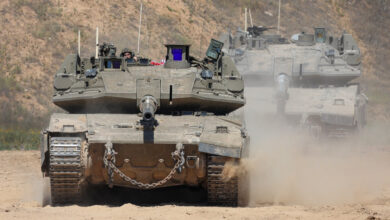India Strikes Pakistan After Kashmir Terrorist Attack: What We Know

India said on Wednesday it had carried out strikes on Pakistan in retaliation for a terrorist attack that killed 26 civilians in Kashmir last month.
The Indian government said its forces had struck nine sites in Pakistan and on Pakistan’s side of the disputed Kashmir region. At least two Indian aircraft were said to have gone down within India and in the Indian-controlled side of Kashmir, according to three Indian officials, local news reports and accounts of witnesses who had seen the debris.
The nuclear-armed archrivals have fought numerous wars, with the disputed area of Kashmir as a prime flashpoint, since 1947, when Britain divided India, its former colony, into two countries, India and Pakistan.
Here is what to know about Wednesday’s strikes, the attack in Kashmir, and the longstanding tensions between India and Pakistan, which both claim the region.
Where were the strikes in Pakistan?
The Indian government said its forces had struck nine sites in Pakistan and on Pakistan’s side of the disputed Kashmir region.
Pakistani military officials said that more than 20 people had been killed and dozens injured after six places were hit on the Pakistani side of Kashmir and in Punjab Province. Residents of the Indian side of Kashmir said at least 10 people had been killed in shelling from the Pakistani side since India carried out its strikes.
Residents of Muzaffarabad, the capital of the Pakistani part of Kashmir, reported hearing jets flying above. They said that a site in a rural area near Muzaffarabad that was once used by Lashkar-e-Taiba, a militant group based in Pakistan, appeared to have been targeted in the strikes.
A spokesman for the Pakistani Army said that five other places had also come under attack, leaving at least eight people dead and 35 wounded.
The targeted locations included Bahawalpur, in Punjab Province, Pakistan, the site of a religious seminary associated with Jaish-e-Mohammad, another Pakistan-based militant group; Kotli and Bagh in Pakistan-administered Kashmir; and Shakargarh and Muridke in Punjab. Lashkar-e-Taiba is believed to have a presence in Muridke.
The Pakistani military said that Indian planes did not enter Pakistan’s airspace while conducting the attacks.
“Our actions have been focused, measured, and non-escalatory in nature. No Pakistani military facilities have been targeted,” the Indian government said in announcing the strikes.
In its own statement, the Pakistani government said that the strikes “will not go unanswered.” It added, “The temporary pleasure of India will be replaced by enduring grief.”
What happened in the Kashmir attack?
On April 22, 26 people in the Baisaran Valley in Kashmir were killed by militants who approached and shot them. Another 17 were injured.
Except for one local Kashmiri man, a government tally of the dead showed that all were Hindu tourists. Accounts from the injured and survivors suggested many were targeted after they were asked about their religion. The attack, which occurred near Pahalgam, a town in the southern part of Indian-administered Kashmir, was one of the worst on Indian civilians in decades.
A group calling itself the Resistance Front emerged on social media to take responsibility. Indian officials privately say the group is a proxy for Lashkar-e-Taiba, a terrorist organization based in Pakistan.
In Kashmir, Indian security forces have begun a sweeping clampdown, arresting thousands of people.
What is Operation Sindoor?
India picked the name “Operation Sindoor” for its military action.
Sindoor, or vermilion powder, is a traditional marker of the marital status of Hindu women. Married women wear it either in the parting of their hair or on their foreheads, and they wipe it off if they become widowed. During the April 22 terrorist attack, many women lost their husbands, who were targeted because they were Hindu.
The Indian government’s choice of the name Operation Sindoor signaled its intention to avenge the widowed women.
“Operation Sindoor” also signals to right-wing Hindu groups — many of which favor more traditionally defined gender roles — that the Hindu nationalist government of Prime Minister Narendra Modi is listening to their demands for vengeance.
But some feminists have criticized the use of the word sindoor.
Hindu nationalism is predominantly driven by a male view of the world, said V. Geetha, a feminist historian who writes about gender, caste and class. “Women figure in it as objects to be protected or as mother figures goading their men to prove their heroism,” Ms. Geetha said.
What are the origins of the dispute?
The roots of the Kashmir conflict trace back to the 1947 partition of British India, which led to the creation of a predominantly Hindu India and a predominantly Muslim Pakistan.
In October of that year, the Hindu monarch of the Muslim-majority princely state of Kashmir acceded to India, but Pakistan laid claim to the territory and sought to take it by military force. A U.N.-brokered agreement in 1949 established a cease-fire line, dividing Kashmir.
After wars in 1965 and 1971, the cease-fire line became the Line of Control, with India possessing about two-thirds of Kashmir and Pakistan the rest. But the dispute remains unresolved.
Here is a timeline of the decades of tensions between India and Pakistan over Kashmir.
Has Pakistan supported militancy in Kashmir?
An insurgency in the Indian-administered part of Kashmir began in the 1980s, primarily driven by local grievances, with Pakistan eventually supporting some groups, experts say.
Among the Kashmir-focused insurgent groups that emerged, some supported independence for the region, while others wanted the Indian side of Kashmir to be taken over by Pakistan.
In the 1990s, Pakistan provided training and other support to several militant groups operating in Kashmir and within Pakistan. This involvement was later acknowledged by several senior Pakistani officials, including the former military ruler Pervez Musharraf. The spike in insurgency in the 1990s forced an exodus of Kashmir’s minority Hindus, a large number of them leaving for New Delhi and other cities after facing targeted attacks.
The insurgency began to ease around 2002, as Pakistan banned Lashkar-e-Taiba and Jaish-e-Muhammad, another major militant group, although Lashkar-e-Taiba continued to operate under aliases. A cease-fire was declared and a peace process with India was initiated, a shift that some observers linked to pressure by the United States after its post-9/11 intervention in Afghanistan.
The peace process collapsed after attacks in Mumbai, India, in 2008, which killed 166 people and were attributed to Lashkar-e-Taiba.
Will India and Pakistan go to war?
Experts say a military confrontation between India and Pakistan, both armed with nuclear weapons, runs the risk of rapid escalation that could be difficult to contain. But India is largely unrestrained by any global pressure to limit its response, and it has become quicker to flex its muscles in recent years as its diplomatic and economic power has grown.
Those looking for signs that the two countries might be serious about de-escalation pointed in part to India’s statements about its strikes. In its public announcements and a flurry of diplomatic activity, India emphasized that its action was limited and targeted, and that it did not seek an escalation.
On the Pakistani side, military and civilian officials tried to keep the narrative focused on what they called Pakistan’s major victory in bringing down Indian aircraft.
What comes next, analysts and diplomats said, will depend on whether the two sides have extracted enough to satisfy their people, and on whether sufficient international diplomacy can be mustered in a time of global upheaval.
What is Kashmir’s status now?
Since war last broke out in 1999, Kashmir has remained one of the most militarized places in the world. India and Pakistan have come to the brink of war several times, including in 2019, when a suicide bombing in Kashmir killed at least 40 Indian soldiers.
In 2019, the government of Prime Minister Narendra Modi revoked a part of the Indian constitution that had given semi-autonomy to the state of Jammu and Kashmir. The move, to fully integrate Jammu and Kashmir, as India’s portion of the region is known, was part of his Hindu nationalist agenda.
Pakistan condemned India’s moves. But violent unrest has broken out in the part of Kashmir controlled by Pakistan, too. Protests there have reflected a general feeling of dissatisfaction with Pakistani rule.
Direct rule by India dampened the outbreaks of violence in the portion of Kashmir it controlled. Voting also resumed last year. But discontent with Mr. Modi’s party, particularly for how heavily it polices the lives of Kashmiris, remains.




